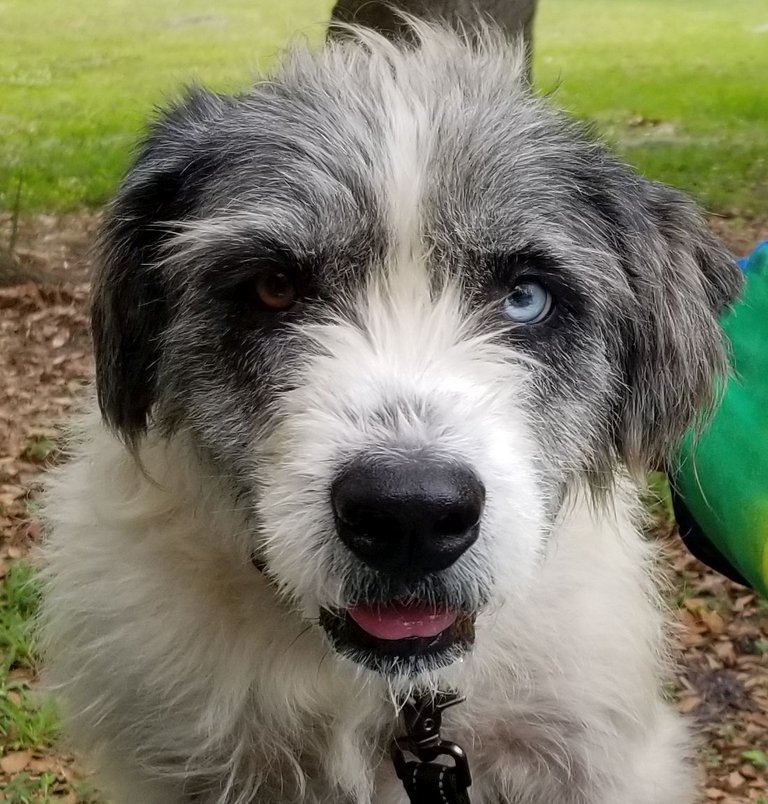

Animal safety
made more difficult when the
danger is our dog.

Ah, the joys of farm life, especially during a quarantine, and especially when those in positions of power, whose job it is to provide a national response to the current pandemic, are simply not bothering to do so.
No question about it; we are certainly living in interesting times.
That said, one of the blessings of small-scale farming is the animals, which in our case includes a dog and three cats, five rabbits, and a mixed flock of chickens and Muscovy ducks. And that's not counting our seven plus aquariums inside the house.
Until recently, we had a flock of eight birds: Two Muscovy duck hens, a Blue-laced Red Wyandotte rooster named Rutger, three Silver-Laced Red Wyandotte hens, and two mixed hens, hatched from the cross between Rutger and the three Silver-Laced hens.
And this spring, despite giving our broody Muscovy hen first eight eggs, then another seven, only one egg hatched; and, naturally, although we're obviously sure of the father, we have no idea who mom was, whether it was one of our Silver-Laced hens, or one of their Silver-Laced with Blue-Laced cross daughters.

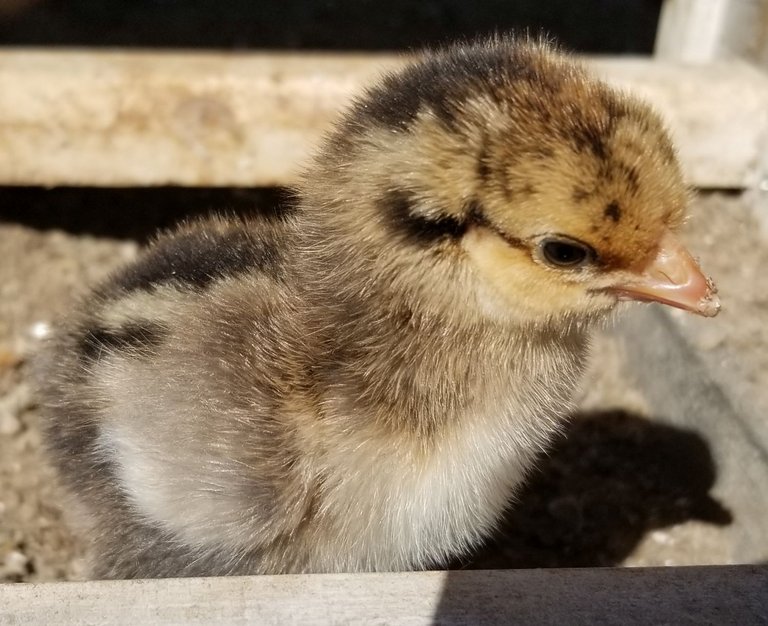

Then one afternoon, when Marek and I were hanging out, and I was checking local farm listings online, I spotted an ad from Pikeville, not far from us, advertising a breeding pair of Svart Hona chickens for a fraction of the normal price. Score!!!
Marek has wanted Svart Honas for over a year, so I immediately called, and though we were disappointed to learn that she had just sold her last pair, she told me that she had three young roosters left, and Marek immediately decided to take them. ALL of them. Yikes!
There is still an off chance that one of the young roosters may actually be a hen, and over the past few weeks I've become more and more convinced that s/he is, as she is smaller than the other two, and her comb isn't nearly as large. Here's hoping!
Svart Honas are a really interesting Swedish landrace breed, as they are entirely black, including their feathers, legs, skin, wattles and comb, and even their flesh, and internal organs. They are also good layers of medium large eggs. And, having originated in Sweden, they are extremely cold hardy, which is always a good thing where you get sub-freezing weather.
There is another all-black landrace chicken, the Ayam Cemani, but as they originated in Indonesia, which has a truly tropical climate, they are not likely to do nearly as well in sub-freezing temperatures as the Svart Honas. And, so far at least, our past few weeks of temperatures up to 99 degrees Fahrenheit, with ridiculous humidity hasn't phased them, so clearly they can tolerate the heat, which is vital in the South.

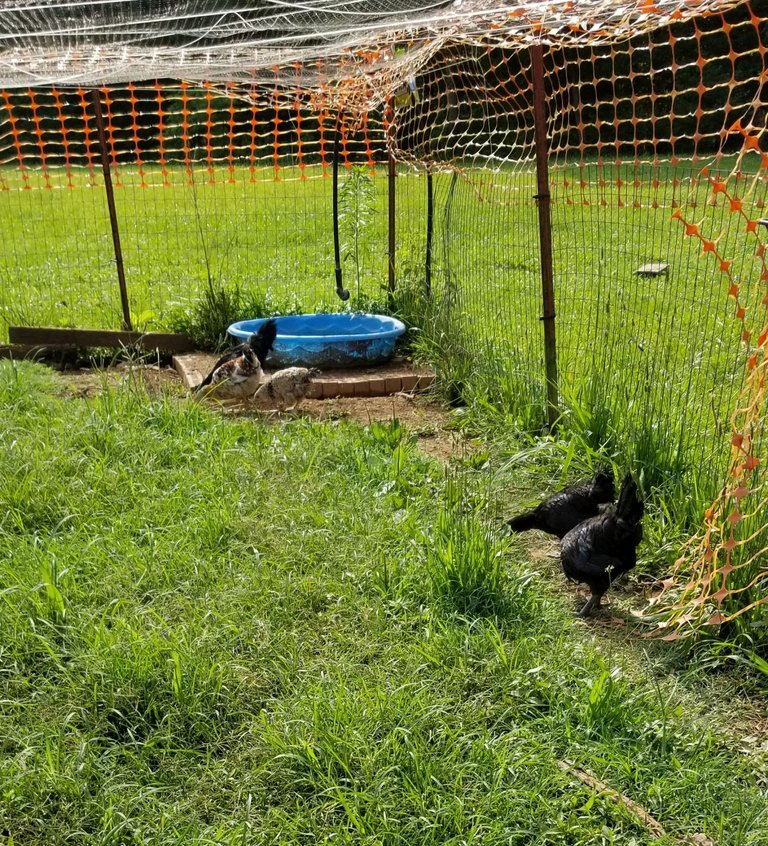

The woman who had the Svart Honas also had another Swedish landrace breed, Swedish Flower chickens, which have lovely feathers that somewhat resemble a field full of flowers, hence their breed name. So I also bought a breeding pair of the Swedish Flower chickens, including a lovely rooster with the normal coloration, and a hen of a much rarer coloration pattern, known as snow leopard. They are both gorgeous.
In the photo above, two Svart Honas are in the foreground, on the lower right, and the Swedish flower pair are in the background, next to the kiddie pool, which doubles as their watering trough, with the third Svart Hona. I was lucky to get this shot, with just the five new chickens, without the rest of the flock photobombing them. ;-)
It was fully dark when we got the five new chickens home, so I simply placed the dog crate in which we had transported them into the larger poultry enclosure, and opened the door, so they could come out at will when the sun came out. I wasn't sure what Rutger would do, given potentially four new roosters in his enclosure, but we hoped for the best, and determined to get a new chicken tractor built quickly.
Happily, it is a fairly large enclosure, at roughly 28 feet wide and 43 feet long, so there is quite a lot of room for each bird, even with the rabbit cages in the enclosure. And the grass is growing fairly tall, especially in the center, so the birds can hunt for bugs all day, almost as though they were pastured. In another six or eight weeks, I'll start seeding some Arctic winter peas and other winter greens, so they'll be able to continue foraging even in the dead of winter.
And so far so good, as although the Swedish chickens are all considerably smaller than the Wyandottes, and are not likely to get much larger, while they have been chased by the larger chickens, and occasionally pecked at, I have yet to see any abuse that would result in actual injury to the smaller birds. Just a few pulled feathers so far, so it seems that the newcomers have been more easily accepted in the flock than I feared.

So our flock of eight has now become a flock of fourteen, which could get interesting, as the young roosters should start crowing pretty much any time now. The chick hatched on 13 June, so is just over six weeks old, so we likely have a good two or three months before he starts crowing, if indeed he is a rooster.
We got the Svart Honas and the Swedish Flower Chickens on 5 July, so nearly a month has passed, which means that they are now between five and six months in age, which makes me curious why I've not yet seen or heard the younger roosters start crowing.
Although I did hear a slightly odd sounding crowing this morning, as though Rutger got something stuck in his throat, so that may be the beginning of the end of my sleeping in for a while.
Landrace breeds are unusual, in that they were not developed through selective breeding to conform to a breed standard, but simply through natural breeding in their pace of origin, and through natural and human selection for survivability, and for other desirable characteristics.
As a result, it is difficult to pin down the ancestral breeds, many of which are likely extinct, although DNA certainly helps to narrow the field somewhat. But, in most cases, their full lineage is never known with certainty. And, in landrace breeds, there is also no such thing as a pedigreed bird, so ensuring that you have purebred birds is more difficult as well.

I first became familiar with the concept of landrace chickens a few years ago, through the Livestock Conservancy, when I read about Icelandic chickens, an amazing breed that forages well on its own, and survives in even the harshest conditions provided by a volcanic island in the middle of the North Atlantic Ocean.
Icelandic chickens were the only chickens in Iceland for over a thousand years, having descended from the Norse breeds originally brought to the island by settlers in the early Middle Ages, around the ninth or tenth century, and they interbred freely during that time.
This has resulted in a very hardy breed with highly variable looks, colors. body shapes, and other characteristics, though all are excellent foragers, most lay well even well into the winter, and though not all go broody, those that do are good mothers.
According to the Livestock Conservancy, no Icelandic chickens have feathered legs, which I find interesting in a bird originating from Nordic breeds, but then, neither do our two Swedish breeds.
Unfortunately, Icelandic chickens do not do well when confined, and as we have a number of predators that would LOVE a chicken dinner, I've decided against the breed for now, particularly since both Lolo and our cats often scout the enclosure, looking for an easy chance at a nice plump chicken or duck.

We did lose one of our turkey chicks to a predator last year, my guess is to a raccoon, when Momma duck built her nest too close to the fencing, and it managed to reach through and grab the chick. I found no remains of the chick, but Momma duck had an injury to her chest, just in front of her right wing, which I'm guessing she sustained trying to save her chick, as there was a pile of her feathers next to the nest.
Happily, she healed well, and there is no longer any sign of the injury. It clearly didn't slow her down any, even at the time. She now happily nests inside the coop, several feet away from the fence on all sides, safe from raccoons, skunks, opossums, and other small predators.
Which does leave us with the mystery of disappearing eggs, for which I still have no real explanation, and I'm guessing we'll have to set up a game camera to find our for certain. The short version is that every time I've given eggs to our broody duck, and one of our broody hens, they sit on them for a few days, after which they begin disappearing, first one or two at a time, but then in groups, with the record so far being five lost in one day.
The bizarre thing is that there is never a sign of the eggs, not a single eggshell, clearly no predator has breached the enclosure, none of our birds or rabbits are harmed or missing . . . and yet the eggs have simply vanished.
Weirder still, though Rutger has clearly been doing his job, last year we had a total of two chicks successfully hatched, and this year so far a total of one. After the fifteen eggs given to the duck before our little guy hatched, I've since given her another eight eggs, which are now down to two; and I gave another eight to one of our Silver-Laced hens, which are now completely gone.

The gentleman from whom I got our Silver-Laced Wyandotte hens told me that he raised Blue-Laced Wyandottes as well, but that with the Blue=Laced Wyandottes he had successfully raised about seventy-five chicks, whereas with the Silver-Laced, he had raised several hundred, from a similar number of breeders.
So is it a fertility issue?
Time will tell, but I have decided to get a decent automatic incubator, to see if we have more success actually raising chicks that way. It may be as simple as the girls not sitting on the nests enough, but as my great-gransmother always let her bantam chickens do their own thing when it came to raising their chicks, I just don't know. A chicken expert I'm not, at least not yet.
Meanwhile, I was in hysterics yesterday afternoon, when I came out to gather the eggs, and heard what sounded like a squeak or two from our youngest cat, Truffle, and then saw a very upset mockingbird scolding something I couldn't yet see. Sure enough, it was Truffle, who was lounging in the shade of our witchhazel bush, with the mockingbird very determinedly divebombing near her to get her to move away.
I'm not sure where their nest is, but obviously somewhere close, and when I came back outside a few minutes later, Truffle had moved further out into the open, on the north side of the enclosure in the driveway, and the mockingbird was making passes closer and closer, until it finally managed to smack her a couple of times during its divebombing passes.
I called Truffle over to me, and she gladly came to escape the demon of the sky, and I brought her inside where it was safer. All our cats sleep inside the house at night, and usually Truffle wants to spend the rest of her time outside, but this time she was quite pleased to get away from that divebombing mockingbird.

I did have a scare one afternoon, when I came out to give the rabbits clean water, and found our young chick just outside the enclosure, right by the door. I'm not certain how s/he got out, as he seems far too big at this point to get through the 2" x 3" openings in the welded wire fencing, but my immediate concern was that Lolo and two of our three cats were outside, making his continued existence precarious.
Luckily, I've been handling him since he hatched, so although he pitches a fit every time I pick him up, he is still comfortable walking right up to me, and settles down immediately. I quickly scooped him up, took him back inside the enclosure, settled him next to his Muscovy "mom," and breathed a sigh of relief.
I'm calling him "he" because, as of now, I'm fairly certain that he is indeed a rooster, as he is taller and stands more erect than I remember our two cross hens being at that age, and he's seriously cocky, which is a good clue in itself.
A few days ago, I was on my way out to feed the chickens, when Lolo, who was standing in front of the enclosure and would NOT move, made it clear that his interest was elsewhere. To my horror, I realized that the little guy was outside the enclosure again, not four feet from where Lolo was standing at alert.
Knowing that Lolo would NOT mind me, and leave the chick alone, I quickly set down what I was carrying, grabbed his collar, and bodily dragged him into the house. Luckily, he didn't fight me, and under the circumstances was relatively cooperative, all things considered. Thank goodness.

I spilled the chickens' scratch grains in the process, but that was a small price to pay for saving the chick, and no doubt our song birds will reap the bounty. Definitely a better solution than watching Lolo kill the chick right in front of me.
A couple of months ago, I noticed that Truffle was playing with something in the yard, and when I got closer, I realized that she had cornered a baby Eastern Cottontail, one of our native rabbits. I tried to get it from her, but in the process Lolo barged in front of me, and even though I yelled "Leave it!" he grabbed it, and I heard it scream as it died.
I do NOT want to go through that again. I've written before about when one of my breeding Silver Fox rabbits escaped her hutch, and Lolo found her before I did. Definitely not a fun memory.
Yes, we have a lot of Eastern Cottontails, and they are certainly in no danger of extinction, but I far prefer that they live out their natural lifespans, than that my dog end their lives prematurely. It's certainly not as though Lolo or our cats need to hunt for their food; they are all fed well, and are certainly not starving.
That said, Lolo has always had a high prey drive, despite mom being a purebred Great Pyrenees, and a livestock guardian dog at that. Evidently Lolo never got the memo that he's supposed to be protecting our animals, not trying to eat them, and that's something that you can't just train out of a dog. We've had numerous discussions about this. Lolo remains unimpressed. Once a hunter, dogs remain hunters, and that is simply our current reality.

I currently have a roll of 4' wide x 1/2" hardware cloth on order, in order to make a chicken tractor for our Swedish chickens, and ultimately several more, so that we can keep all our breeds separately, ensuring purebred offspring, while protecting them from predators, but still allowing them to forage on clean pasture.
At the same time, I will also make some breeding cages for quail, which I've always loved, and would like to start raising in earnest. I'll start with jumbo brown Coturnix, a variety of a Japanese breed which mature and begin laying eggs in a mere four weeks, and can quickly become an income stream to help pay for our rural farm and animal habit.
Then, once I've mastered the learning curve, and have become comfortable with raising them, I'll try my hand at raising different breeds of quail, some of which can be quite challenging to raise.
But, as a California girl, I've always dearly loved California quail; and now living in Tennessee, I'd love to raise some native Northern bobwhite quail to release on our acreage.
I've written before about a man I met in California, who became a good friend, who started raising and releasing California quail in the Santa Monica Mountains in the late 1960s, after returning from Vietnam, because he remembered hearing their calls as a kid, and missed hearing them.
By the time I met him, in the late 1970s, he had released several thousand, and I can attest that, once again, it wasn't uncommon to hear them in the pastures and woods around Topanga Canyon and inland Malibu, although they had been mostly eradicated by hunters decades before.
I would like to emulate his example and do the same thing with native bobwhite quail on our place. Since we live on a largely natural river, which is a natural wildlife corridor, it is my hope that we can not only repopulate bobwhites on our own small acreage, but all along the Calfkiller River; and ultimately, along the larger Caney Fork River Watershed, as our small river empties into the Caney Fork River about three miles south of our place, as the crow flies.
More on that in another post.

Meanwhile, this evening, just before sitting back down to write, I took Lolo outside to go get the mail, just as the sun was beginning to set, and he went into almost instant full alert . . . the little guy was outside the enclosure again. Damn.
So, once again, I dragged Lolo in the house, captured our little escapee, and unceremoniously deposited him back inside the enclosure, naturally through one of the 2" x 3" holes in the welded wire fence, giving them all some extra scratch grains to keep them busy -- and him inside -- until nightfall.
So I guess I'll have to spend some time in the next couple of days finding a way to prevent our chick from continually escaping the enclosure, because I really don't want him to become an untimely snack for any predator, much less our own dog or cats. I have some bird netting on hand that may do the trick. Wish me luck.
My banners were pretty severely out of date the last time I posted, so undoubtedly they are even more so now, and I will make an effort to rectify that in the next few days.
I can't promise to get get back to daily posts immediately, but I will make the effort to post at least a couple of times a week, and I have a lot of ideas in the fire ready to go. And I'll try to keep my posts to a more reasonable length. ;-)
And hopefully, before too much longer, we'll actually be able to gather in person once more, to commune with one another, and just to hang out and enjoy. In anticipation of that, I'll be spending the next couple of days, at least, making more liqueurs. I've missed you all.
Love you all, Cori

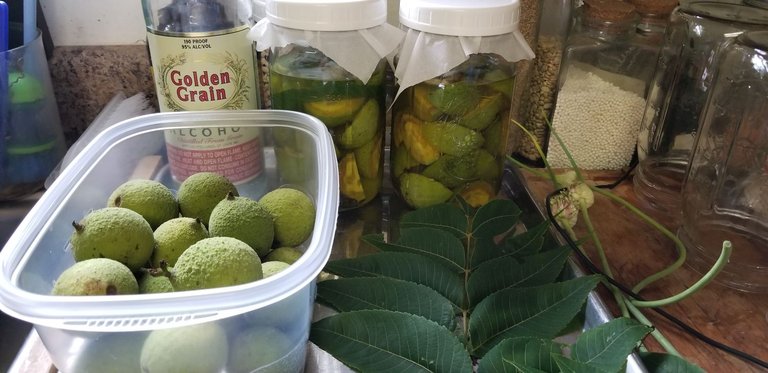

#earthtribe #tribegloballove #isleofwrite #tarc #yah #smg #ghsc #spunkeemonkee #thirtydayhaikuchallenge #teamgood #steemsugars #teamgirlpowa #womenofsteemit #steemusa #qurator #steemitbasicincome #bethechange #chooselove #photography #chickens #ducks #rarebreeds #predators #beauty #love #culture #peacemaking #peacemaker #friendship, #warmth #self-respect #respect #allowing #animals #community #unity #love #loss #mourning






art and flair courtesy of @PegasusPhysics

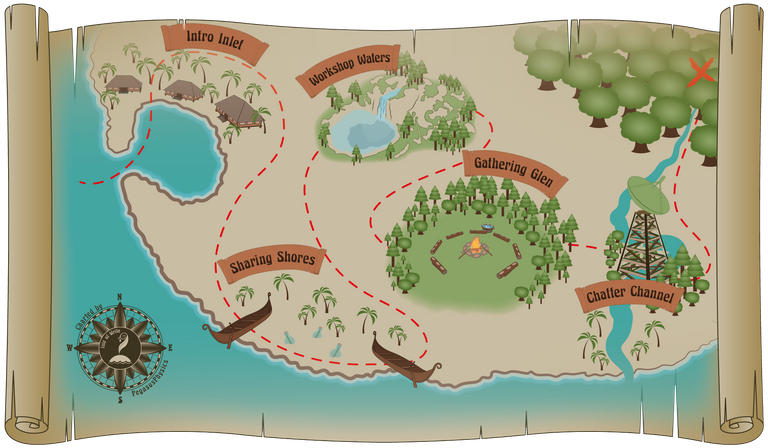
Fancy seeing you out and about the chain again! Hope you end up with a hen and get a breeding pair! Also scary about the little rooster. Did you figure out why the mockingbird was bei g all nutso? I know sometimes they get territorial with their nests but may be more? Anyhooz, glad you all healthy over there! Love and hugs and happy thoughts🤗
Posted using Dapplr
Right back atcha, @enginewitty! Glad to be back.
As far as our mockingbirds are concerned, it was clear that they have a nest somewhere near, but I still haven't found it. But, even though Truffle has been out every day, they haven't repeated their performance, so who knows?
Mockingbirds doing what mockingbirds do.
The single funniest - and most impressive - display I've ever seen from a mockingbird, was when I still lived in Florida, and standing in my front yard in Largo, watched a pair of mockingbirds CHASE OFF A FULL GROWN BALD EAGLE because it had gotten too close to their nest in our huge ficus tree.
They're completely fearless when it comes to protecting their nests!
I've watched them chase off ospreys, red tailed hawks, and other raptors, despite the fact that any one of these birds of prey could have easily decided to have a mockingbird snack, and end the entire exchange.
And, speaking of bald eagles, we seem to have one or more as new neighbors, as my next-door-neighbor recently showed me a photo he took of one feeding on roadkill a mile or so down our street, and then I spotted one overhead as I returned home a couple of days later, less than a quarter mile north of my place.
I'm completely thrilled, as one of the things I miss the most about our place in Florida is the large number of bald eagles and ospreys we had in the area, including a park with several nests by the lake, less than a mile from our house.
We used to have both bald eagle nests and osprey nests all over Pinellas County, as the whole county is a designated bird sanctuary, and the birds absolutely know it.
I once told my sister that, if I was ever in a one-car accident, if it happened during daylight hours, she could be pretty certain that I was most likely watching either dolphins, ospreys or eagles.
And, one of my absolute favorite things about having a sunroof is that, when photographing birds, if you slam a car door, they'll fly away. But, if you just park, and pop up through the sunroof to film them, they couldn't care less, it doesn't bother them, and they just view you as part of the landscape.
I had an absolute blast photographing birds in Florida.
;-)
Congratulations @crescendoofpeace! You have completed the following achievement on the Hive blockchain and have been rewarded with new badge(s) :
You can view your badges on your board And compare to others on the Ranking
If you no longer want to receive notifications, reply to this comment with the word
STOPDo not miss the last post from @hivebuzz: